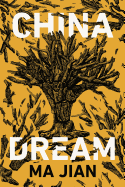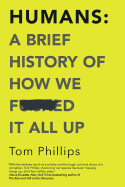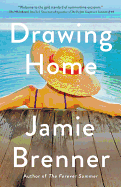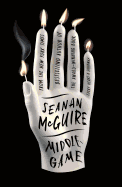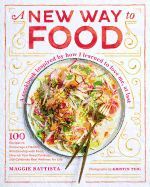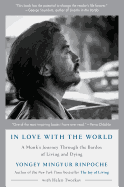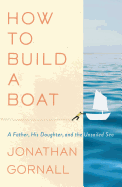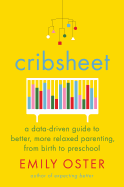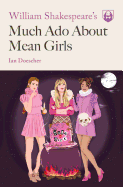Tuesday, May 7, 2019
Bonk. Gulp. Stiff. Popular science writer Mary Roach's body of work--often quite literally corporeal--boasts many titles that might seem rather primal. Primal they may be, but in Roach's books, they become complex, delightful and surprising. These standouts perfectly capture Roach's singular style.
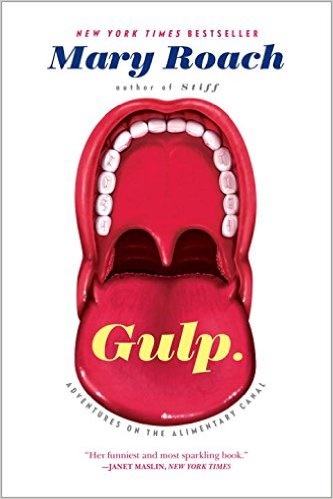 Gulp: Adventures on the Alimentary Canal (W.W. Norton, $15.95) is a particularly fine place to start with Roach's work. She explores the human digestive system from nose to tail, in fabulous detail. Her journey to understand its mechanics leads her to visit pet food researchers, some very frank prisoners and Elvis Presley's doctor, among many others.
Gulp: Adventures on the Alimentary Canal (W.W. Norton, $15.95) is a particularly fine place to start with Roach's work. She explores the human digestive system from nose to tail, in fabulous detail. Her journey to understand its mechanics leads her to visit pet food researchers, some very frank prisoners and Elvis Presley's doctor, among many others.
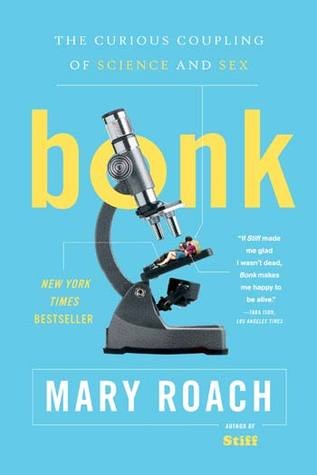 In Bonk: The Curious Coupling of Science and Sex (W.W. Norton, $15.95), Roach vividly details the study of sex. Fans of her viral TED talk on the female orgasm will find much to love, as will anyone wondering what happens between Roach and her husband in an MRI machine for the sake of science. Or about the mating habits of porcupines.
In Bonk: The Curious Coupling of Science and Sex (W.W. Norton, $15.95), Roach vividly details the study of sex. Fans of her viral TED talk on the female orgasm will find much to love, as will anyone wondering what happens between Roach and her husband in an MRI machine for the sake of science. Or about the mating habits of porcupines.
 "We are biology," Roach writes. "We are reminded of this at the beginning and the end, at birth and at death. In between we do what we can to forget." In Stiff: The Curious Lives of Human Cadavers (W.W. Norton, $15.95), she explores the fascinating history of cadaver research with respect--reverence even. Sample interviewees: a specialist who studies bodies from plane crashes; embalming students at a mortuary college; automotive impact researchers.
"We are biology," Roach writes. "We are reminded of this at the beginning and the end, at birth and at death. In between we do what we can to forget." In Stiff: The Curious Lives of Human Cadavers (W.W. Norton, $15.95), she explores the fascinating history of cadaver research with respect--reverence even. Sample interviewees: a specialist who studies bodies from plane crashes; embalming students at a mortuary college; automotive impact researchers.
Through her boundless inquisitiveness, Roach finds the humanity, the silly and the transcendent in life around us. --Katie Weed, freelance writer and reviewer
China Dream
by Ma Jian, transl. by Flora Drew
China Dream is a deeply felt satire of modern-day China under President Xi Jinping by Ma Jian, whose works have been banned in his home country ever since the release of his first book decades ago. Ma Jian takes aim at Xi's "China Dream of national rejuvenation" for attempting to replace dark memories of the Communist Party's reign with "rabid consumerism" and "inflated nationalism." His protagonist is Ma Daode, director of the China Dream Bureau. In one of the novel's occasional fantastical touches, Ma is preoccupied with the creation of a neural implant called "the China Dream Device," which he plans on first inserting into his own head so that "any dream from my past still lingering there will vanish into thin air." Ma is in urgent need of that device because memories that he would rather suppress have begun to surface, forcing him to reckon with his--and the nation's--violent, disturbing past.
In the foreword, Ma Jian writes that "in evil dictatorships, most people are both oppressor and oppressed." His portrait of Ma Daode is similarly multifaceted, invoking ridicule and sympathy in equal measure. The book contains somewhat magical concepts like the China Dream Device, but they are often hard to distinguish from the real-life absurdities that emerge under totalitarian systems. Perhaps most absurd, Ma Jian seems to suggest, is the government's attempts to bury a past filled with so many skeletons. There will always be people like Ma Daode who remember even what they'd rather forget. --Hank Stephenson, bookseller, Flyleaf Books, Chapel Hill, N.C.
Discover: China Dream is a satire about Xi Jinping's China in which a corrupt bureaucrat finds his position and his sanity threatened by memories of his bloody role in Mao's Cultural Revolution.
Drawing Home
by Jamie Brenner
Emma Mapson, a busy single mom, expects that the summer season will be a little crazy, with her teenage daughter, Penny, out of school and the touristy crowds flooding the American Hotel where she works. But to Emma's shock, this summer becomes wildly different from any other Sag Harbor, N.Y., summer. First, celebrated artist Henry Wyatt, who had been helping Penny with her dreams of writing a graphic novel, dies in the lobby of the American Hotel. Then, Emma discovers that Henry left his vast beachside mansion to her daughter.
But Henry's business partner and friend of decades, Bea Winstead, turns up, claiming that Penny and Emma must have tricked Henry into leaving the house to them, because he'd always planned to have it turned into a museum for his artwork after his death. Bea battles Emma for the house, and Emma worries about Penny, whose OCD has gotten markedly worse in the wake of Henry's death. In the background, the idyllic Sag Harbor setting provides the perfect relaxing counterpoint to the tension in Emma's life.
Readers of Elin Hilderbrand or Nancy Thayer are sure to love Drawing Home, a charming entry in the heartwarming beach read canon. Jamie Brenner (The Forever Summer, The Husband Hour) has created a slew of likable, flawed characters, all struggling to handle their grief at Henry's death and figure out his apparently conflicting final wishes. Emma, Bea and Penny end up learning surprising lessons about themselves and each other as the summer unfolds. --Jessica Howard, bookseller at Bookmans, Tucson, Ariz.
Discover: In this comforting beach read, a single mother is shocked when a famous artist leaves his mansion to her teenage daughter.
Science Fiction & Fantasy
Middlegame
by Seanan McGuire
In a fantasy as deftly twisted as her Wayward Children series, Nebula winner Seanan McGuire (That Ain't Witchcraft) once again demonstrates her instinct for turning sweetness into darkness.
Twin siblings Roger and Dodger reconnect during elementary school after their separation at birth, but their reunion is no Hayley Mills summer camp singalong. For one, they live on opposite coasts of the United States and communicate through an inexplicable telepathic link. For another, the twins weren't born but built and harvested in a secret lab by James Reed, who has ambitions to rule the world.
By design, Roger has great facility with language and strong powers of persuasion, while Dodger lives for mathematics and can reset the timeline of the universe. As they grow up, the twins connect psychically but are separated repeatedly. Eventually, aided by another construct whose twin was murdered, Roger and Dodger must decide whether to remain puppets or take the fight to Reed.
Alchemy and its pseudoscientific accoutrements strike the perfect balance between the mystical and the eerie in this high-concept fantasy. McGuire's penchant for snappy, character-revealing dialogue carries the day and makes the more mind-bending plot twists go down easily. References to L. Frank Baum, the Midwich Cuckoos and more recent pop culture also help to break down the sometimes dense logical structure for the reader.
As atmospheric and suspenseful as a gothic thriller, Middlegame is at heart a loving examination of the push-and-pull nature of the sibling bond, in which the parties can simultaneously be best friends, worst enemies and each other's biggest weakness. Readers should come for the tightly constructed world and stay for the pleasure of watching the twins choose each other, come what may. --Jaclyn Fulwood, blogger at Infinite Reads
Discover: In this standalone fantasy by the author of The Wayward Children, telepathically linked siblings can achieve godlike powers if they manage to survive.
Food & Wine
A New Way to Food: 100 Recipes to Encourage a Healthy Relationship with Food, Nourish Your Beautiful Body, and Celebrate Real Wellness for Life
by Maggie Battista
Maggie Battista has tried "every diet or lifestyle plan ever invented... low fat, low carb, mostly grapefruit, and high protein." But finding that none of these cured the "desperately desperate" way she felt about her body, Battista realized that something needed to change in order for her to feel happy in her own skin. And so was born her "new way to food," a style of cooking, eating and thinking designed to reset her relationship with food altogether. Battista documents this way of eating, along with accounts of her own personal journey "from fat girl to mostly well and happy-to-just-be-me lady" in her cookbook of the same name. She's quick to point out that the book is not a diet book, but a collection of advice and suggestions to transform one's eating and one's attitudes.
Many of the dishes here are vegan, like a meatless take on Bolognese sauce and vegan chocolate chip cookies, but Battista doesn't shy away from meat altogether; there are also dishes like Steak au Poivre and Smoky Paella with Fennel. All of the recipes feature fresh, wholesome ingredients and easy-to-follow instructions, and are accompanied by notes on how often a dish might be featured in a meal plan. These recipes sit side-by-side with tips on things like how to think about healthy eating, how to revamp your pantry and your meal-planning routines and how to love yourself. This makes A New Way to Food not only a beautiful exploration of colorful, wonderful foods, but the kind of cookbook packed with enough narrative that readers will want to make time to sit down and read the whole thing cover to cover. --Kerry McHugh, blogger at Entomology of a Bookworm
Discover: In this colorful, personal cookbook, Maggie Battista offers recipes, tips and advice for building a healthy relationship with food and one's body.
Biography & Memoir
In Love with the World: A Monk's Journey Through the Bardos of Living and Dying
by Yongey Mingyur Rinpoche and Helen Tworkov
Nepal native Yongey Mingyur Rinpoche (The Joy of Living) entered the monastery as an 11-year-old, and by 2011, then age 36, he found himself the abbot of three Tibetan Buddhist monasteries. Through his organization Tergar International, he was also the leader of a worldwide network of meditation communities. On June 1, 2011, under cover of darkness and without a word to his followers, he traded his privileged heritage and sheltered surroundings in a monastery in India's Bodh Gaya for the harsh existence of a solitary wandering yogi, an "ego-suicide mission" he planned to pursue for at least three years.
In Love with the World focuses on the first few profoundly consequential weeks of Mingyur Rinpoche's itinerant retreat. He vividly describes that new environment, beginning with the sensory shock of encountering life in a packed, foul-smelling coach on the train to the Hindu holy city of Varanasi, sharing his existence in an elemental way with some of the most impoverished members of Indian society.
But the heart of the book is a terrifying account of his near-death experience in Kushinagar. He is stricken with a catastrophic case of food poisoning, after dining on scraps he begs from a nearby restaurant when he spends his last rupee. As his illness deepens, he drifts in and out of consciousness, and draws upon a lifetime of intensive meditation practice to inhabit his experience.
In Love with the World takes the reader inside the mind of a meditation master, with much the same feeling one might have listening to a world-class musician or artist describe the process of executing a complex work. --Harvey Freedenberg, freelance reviewer
Discover: A prominent Buddhist monk describes his intense spiritual experience at the beginning of a lengthy wandering retreat.
Social Science
Humans: A Brief History of How We F*cked It All Up
by Tom Phillips
For everyone who's ever said, "We'll look back on this one day and laugh"--and even anyone who hasn't--Tim Phillips's Humans: A Brief History of How We F*cked It All Up is for you. The London journalist looks back on the whole of human existence to examine some truly catastrophic mishaps in areas such as the environment, war, colonization and more. And through his theme of "our deep and consistent ability to fool ourselves with stories and delusions about what it is we're actually doing," he gives his readers plenty to chuckle about.
Beginning with Lucy, whose fossilized remains introduced scientists to a new species they believe is the missing link between humans and apes; touching on the Cuyahoga River catching fire, repeatedly; and even analyzing Hitler's invasion of Russia (a rerun of Napoleon's fiasco), Phillips employs brilliantly sarcastic wit to make his history text lively, informative and superbly entertaining. He calls out humans on their propensity for greed, and he identifies racism, often mocking the utter idiocy of rationalizations for bigotry--as he does in his coverage of Easter Island: " 'Aliens must have done it' is a remarkably popular and obviously extremely rational solution to the conundrum of nonwhite people building things that white people can't imagine them having built."
Humans have a colorful history of mucking things up. Sometimes it's because of the skills we have that other species do not--seeing patterns, communicating, imagining the future--sometimes it's as simple as greed, arrogance or alcohol. But no matter the reason, Phillips delivers the story with clever style and verve, making it fascinating and fun. --Jen Forbus
Discover: A journalist and humor writer takes readers on a hilarious history tour of the human race's monumental failures.
No Visible Bruises: What We Don't Know about Domestic Violence Can Kill Us
by Rachel Louise Snyder
Journalist Rachel Louise Snyder used to think of domestic violence as "an unfortunate fate for the unlucky few," a hardwiring gone wrong. But then an acquaintance offered a new perspective: that this is a social epidemic, one it is possible to prevent. No Visible Bruises: What We Don't Know About Domestic Violence Can Kill Us is the product of copious, immersive research, an investigation into a universal and insidious violence and what can be done about it.
Snyder presents her findings in three parts, ordered as "The End," "The Beginning" and finally "The Middle." That is, she first studies what intimate partner violence looks like at its conclusion: homicide and regrets that various systems (judicial, law enforcement, advocacy, etc.) couldn't do more. Next, she investigates the beginning of such violence. Abusers often come from abusive home environments and, along with their victims, grow up in a society that values stoicism, control and violence in men, submissiveness and emotional labor in women. "The Middle" examines how services are provided to victims of domestic violence, and what changes should be considered.
No Visible Bruises sounds like an appallingly dark read, and it's true that the content is deeply disturbing. But by focusing on case studies--individuals' stories--Snyder returns humanity to the horrifying larger issue. The result is an impressive body of knowledge about domestic violence in the United States: what it looks like, its terrifying prevalence, what works and what doesn't in trying to stem the tide. Snyder speaks with urgency about solving a problem that, however invisible, affects us all. --Julia Kastner, librarian and blogger at pagesofjulia
Discover: This thoroughly researched examination of the domestic violence epidemic is chilling but deeply important and surprisingly accessible.
Travel Literature
How to Build a Boat: A Father, His Daughter, and the Unsailed Sea
by Jonathan Gornall
Jonathan Gornall has been boat- and water-obsessed for many decades, but he is the first to admit that, as a longtime chair-bound freelance journalist, his DIY skills are nil. The idea of him building anything from scratch is unlikely. But Gornall is also giddy with joy at becoming a father again at age 58. As he seeks a project sufficient to show his new daughter his love and hope for her life, the idea feels natural, even obvious: he will build her a boat.
How to Build a Boat: A Father, His Daughter, and the Unsailed Sea is a love letter to that small child, Phoebe. It is a memoir of a life on and off of water and a study of the history, art and science of boatbuilding. Gornall considers his first sea voyage (in utero, with an unwed mother who consistently claims he's ruined her life), his first experiences with boats (at boarding school) and his significant time on the ocean. Gornall has twice attempted to row across the Atlantic, with enormous press and personal pressure, and twice failed: these disappointments weigh heavily on him and contribute to the urgency to get this boating effort right.
Gornall's tone is drily funny and always self-deprecating. His research, however, is as serious as his journalistic background would suggest. The result is a deeply moving intersection of the personal with the practical. This is not quite a how-to manual, but readers with aspirations to fashion their own boat would have a headstart upon reading. If the boat is a gift to Phoebe, this book is another. --Julia Kastner, librarian and blogger at pagesofjulia
Discover: A father ill-suited to DIY projects builds a boat for his daughter, and in the process writes a charming, heartfelt love letter to both boat and child.
Parenting & Family
Cribsheet: A Data-Driven Guide to Better, More Relaxed Parenting, from Birth to Preschool
by Emily Oster
In her 2013 book Expecting Better, economist Emily Oster equipped pregnant people with the data and information they need to make informed, evidence-based decisions about their pregnancies. The book's straightforward, judgment-free presentation of the data made it a big (if somewhat controversial) hit in a world where expectant parents are bombarded with abundant, and abundantly confusing, advice.
Now, Oster is taking a natural step forward with Cribsheet, a similar guide for parents navigating the first three years of their child's life. What does the data say about when to give your newborn her first bath? Are the apparent benefits of breastfeeding more correlational than causational? Are things like co-sleeping or "crying it out" truly harmful? How do various childcare options affect developmental results? And how much "screen time" can we get away with, really?
These questions may not have clear-cut answers, but Oster can tell you exactly what the data says (and also, anecdotally, share her own wisdom as a parent of two). In addition, she will give you some insight into how trusted organizations like the American Academy of Pediatrics make their recommendations.
Crucially, Oster's goal is to present readers with a thorough but accessible and layperson-friendly analysis of the available data on a given topic, and leave the decision-making up to them. Considering how fraught, frightening and often contradictory the discourse on these topics can be, Oster's even, friendly tone is both refreshing and reassuring. --Hannah Calkins, writer and editor
Discover: For expecting parents, new parents or veteran parents, Cribsheet is a welcome, straightforward guide to making decisions about the first years of their child's life.
Poetry
Brute
by Emily Skaja
Poet Emily Skaja, recipient of the Walt Whitman Award of the Academy of American Poets, writes visceral, tactile pieces about love and aggression in her first collection, Brute. These are poems of rage and tenderness, sometimes embodied in one breath and the next, but it is Skaja's attention to the natural world that surfaces again and again as the speaker's preoccupation. "It's Impossible to Keep White Moths" bursts forth into its first line to complete the thought, "from flying out of my mouth." She adds, "ravens/ lurk on the Divine Lorraine Hotel as if to say/ Always a corpse flower, never a bride."
Far from being a pastoral collection, however, Brute also dredges up the chilling betrayals of modernity as well. "No, I Do Not Want to Connect with You on LinkedIn" seethes over the cruel trespasses of an ostensibly professional acquaintance. "Trust me when I say we know all about your kind in our ranks," the poet assures him after declaring, "This here is girl country."
A mix of elegies and aubades, plus a litany of girl saints ("Dear Katie," "Dear Ruth," "Dear Emily"), Brute draws to a close over the recurring myth of Eurydice, once "just a woman walking alone/ through a field of snakes." In the end, the poet coaxes her from the underworld, "Come out into the new wet earth," breaking a cycle of death and asserting, "I will lead myself out of it."
Piece by piece, Emily Skaja builds a powerful narrative from singular marvels of imagery. --Dave Wheeler, associate editor, Shelf Awareness
Discover: These potent, magnificent poems cohere into a lucid reflection of modern feminine experiences in the myth of Eurydice.
Children's & Young Adult
William Shakespeare's Much Ado About Mean Girls
by Ian Doescher, illus. by Kent Barton
After a made-for-TV sequel, a novelization and a musical adaptation on Broadway, the wildly popular 2004 teen comedy Mean Girls is now a Shakespearean play in Ian Doescher's Much Ado About Mean Girls.
Doescher (William Shakespeare's Star Wars series) remains faithful to the original script, telling the story of 16-year-old, homeschooled Cady, who has been living in Africa for the past 12 years. Now a student at an Illinois high school, Cady struggles with adapting to life outside the "Afric plains." Outcasts Janis and Damian educate her about their school's social classes, warning her against the uber-popular Plastics. When Plastics leader Regina takes an interest in Cady, her new friends encourage her to infiltrate the group. But as Cady climbs the popularity ladder, she quickly learns that it's a long fall from the top.
Doescher doesn't merely adapt the cult classic; he transforms it. He effortlessly translates scenes and dialogue from the screenplay ("I hear her hair's insured for $10,000") to Shakespearean language and meter (" 'Tis said the lady's hair is well insur'd--ten thousand ducats should it damag'd be"), maintaining its original humor while injecting some of his own. He pays homage by including lines from the Bard's plays, mostly delivered by main female characters who are all paired with a Shakespearean counterpart (according to an afterword), as well as from "extras," like a mall salesperson who quotes Love's Labour's Lost. Barton's handful of black-and-white vignettes aid in bringing together the old and new; for example, showing the Plastics' notorious "Jingle Bell Rock" costumes adorned with ruffs.
Because of Doescher's handiwork, this amalgam of storytelling forms stands on its own. Those already familiar with the film should find this Shakespearean treatment easily accessible, while Bard fans will likely relish the nods to his style and characters. --Lana Barnes, freelance reviewer and proofreader
Discover: This mash-up of Shakespeare and Mean Girls is totally fetch.
Discover Great Publishers
Emphasis on Pop Culture
BookCon
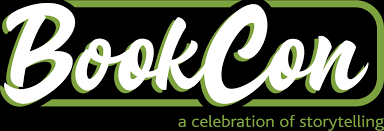 BookCon takes place at the Javits Center on Saturday and Sunday, June 1-2, immediately after BookExpo. It's a wildly popular, consumer-oriented book show with an emphasis on pop culture that started in 2014 and attracts many thousands of readers. Besides a range of author signings, BookCon features panels, the BookCon book club, and writing workshops, which made a highly successful debut last year. If anyone feels the slightest bit jaded about the book business, the best cure is to see the excited crowds at BookCon.
BookCon takes place at the Javits Center on Saturday and Sunday, June 1-2, immediately after BookExpo. It's a wildly popular, consumer-oriented book show with an emphasis on pop culture that started in 2014 and attracts many thousands of readers. Besides a range of author signings, BookCon features panels, the BookCon book club, and writing workshops, which made a highly successful debut last year. If anyone feels the slightest bit jaded about the book business, the best cure is to see the excited crowds at BookCon.
"BookCon is a great place to witness the behavior patterns of passionate consumers," Jenny Martin says. "We see BookCon as the place that feels like home for avid readers. It speaks to who they are inside as book lovers and most of them are also faithful patrons of their local bookstores and libraries. That excitement around stories in all shapes and forms leads to the fans recommending new authors and titles to friends, starting or joining new book clubs, or even becoming writers, booksellers, librarians or editors themselves. The thing that I love about working on these events is that thread of passion runs through the B2B and B2C events. Everyone in this industry is in it because they love it, and that makes our jobs so rewarding."
The 'Show Within a Show'
UnBound
 Another major new event at BookExpo and BookCon is UnBound, a gift-focused "show within a show" that will feature a range of non-book products across 25 categories--including candles, socks, T-shirts, greeting cards, journals, calendars, games, toys and art materials--from more than 100 companies. UnBound will be located in halls 3D and 3E at the Javits Center, where attendees will have a chance to shop these great products and bookish accessories. The product range is "diverse and carefully curated. You'll find a whole host of goodies you never knew you needed but you can't live without!" says BookCon and BookExpo event manager Jenny Martin.
Another major new event at BookExpo and BookCon is UnBound, a gift-focused "show within a show" that will feature a range of non-book products across 25 categories--including candles, socks, T-shirts, greeting cards, journals, calendars, games, toys and art materials--from more than 100 companies. UnBound will be located in halls 3D and 3E at the Javits Center, where attendees will have a chance to shop these great products and bookish accessories. The product range is "diverse and carefully curated. You'll find a whole host of goodies you never knew you needed but you can't live without!" says BookCon and BookExpo event manager Jenny Martin.
| Advertisement Meet belle bear! |


